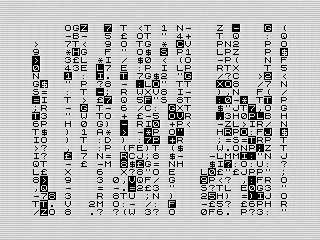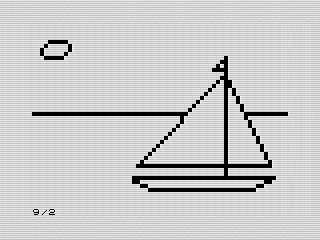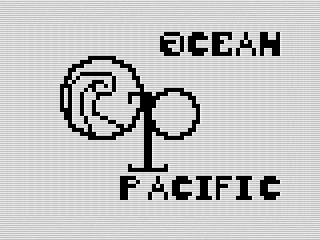For some time now, I’ve wanted to build a running type game. The kind where there is a single key to press and releasing it makes you take an action. There are lots of variations on this theme, and it seemed like something fun to try. Idea in hand, I began by building out a rough look for the game.
Digger Deeper Into My Water Bug II Game for the ZX81
For years, Water Bug II has been an interesting game for me. I was so excited when completing the first version, that I wanted to build another one with ten more boards. The funny thing is, the two games look a lot alike. In fact, if you weren’t paying attention, I wouldn’t be surprised if you thought you were playing the same game. Let’s dig deeper on both the similarities and the differences.
Water Bug Was My Attempt at a ZX81 Action Game
For most of the day, I’ve been thinking about my Water Bug game as I never really gave it a proper write-up. Finally got around to playing it again, I was surprised to find elements in that I thought were unique to Water Bug II are actually in this version. That made me want to walk through each board, understanding better what I had done, what worked, and what didn’t. Let’s dive right in.
An Early and Bad Attempt at a Yars’ Revenge on the ZX81
Like many teenagers in the early eighties, I was playing video games on my Atari VCS. Yars’ Revenge was a popular purchase, and I spent many hours dodging that stupid missile and trying to take down the shields of the Qotile. It then should come at no surprise that I tried to recreate that game at 13. My attempt on the ZX81 didn’t look horrible, but it sure played bad. Let’s see how much.
Your Imagination Is Required With Comp Control for the ZX81
As a young teenager, I often wrote programs that I would integrate into other play. In this case, I had probably watched War Games again. The idea of a computer talking to you made for some fun fantasy play. Comp Control a little pretend play where my lowly ZX81 mimicked a much more sophisticated world. I’m sure I was running around my room thinking up some crazy way to save the world.
Trying My Hand at Animation by Moving a Sailboat on My ZX81
I was hoping to have finished Gem Quest by now, but May didn’t afford much time. With Summer arriving and the pandemic seeming to be winding down, at least in Boise, my attention is elsewhere. With a short list of ideas, I decided to play off last month's theme. Picture in Motion isn’t new, but it is more interesting to watch.
Having Fun Learning How to Draw Lines on My ZX81
When Simeon Dwyer shared his machine language line drawing routine, I immediately thought of redoing “The Picture.” Most of my z80 assembly has been with my Gem Quest game. I decided it would be a nice diversion to work on something else, even if a quick one. Picture Asm is the result of that diversion.
Not My Best Try at Programming an Ultima Clone
I’ve talked about ZX-Ultima before. It was first attempt at building an Ultima like game on the ZX81 using BASIC. Written in 2012, it was a pretty ambitious project for me. I really enjoyed playing Ultima III on my C64 as a teenager. I always wondered what it would look like on my ZX81. It was bad. Yet, at the same time you could see the seeds of what would come later.
A Developer Diary in Pictures for Gem Quest, a ZX81 RPG
If you’ve been following me the last couple of months, you know I’ve been revisiting Gem Quest. Intended to be an Ultima style game for the ZX81, outside of a few demo’s I really hadn’t gotten far. That isn’t the case now. I’ve spent the last month learning z80 assembly code and hacking my way through the game. Tracking my progress, I’ve been capturing that journey in pictures and movies, which I’ve uploaded into a Flickr album.
How to Build a ZX81 Ultima Game Part 2: Gem Quest
After sharing Tiles, I started to dig into my previous attempts at building an adventure game. Digging through my past research, I thought about encoding the world differently. Sadly, my experiments using MCODER failed. This spurred me to try assembler again and, to my surprise, build a good start to my game. But first, a trip down memory lane and review my first attempt at building Gem Quest.
How to Build a ZX81 Ultima Game
In 2012 I wanted to see if I could make an Ultima style game on the ZX81. I had an ambitious plan centered on the tile based graphics. After a few months of testing, I was able to create a working prototype called Tiles. Although the game isn’t done, the idea behind it shows promise. You can move around the map using the standard ASDW movements. Other commands are placeholders for what could be. This article explores how Tiles came to be.
How I Used My ZX81 to Draw the Iconic OP Logo
As 2020 wound down, I had a couple of different ideas for new ZX81 programs. Most of them were graphic programs of various sorts. Themes ranged from dumpster fire pictures, an advent calendar, a virus action game, to a solo RPG. Although they were all great ideas, I didn’t think I’d get any complete enough to publish. In the end, I decided to enter in one of my old graphic programs of the Ocean Pacific logo.
Creating Charts on Your ZX81 Couldn’t Be More Simple
As usual, I procrastinated a bit in finishing my ZX81 program for November. Between holidays, work, and NaNoWriMo, I didn’t get around to it until this last weekend. I decided to try something a little different for this month’s program. The program itself, Charts, is a simple line graph plotter—spelling and bugs galore. As interesting as that program is, the real story is how I entered it.
Entering a Program Shouldn't Be This Frustrating
Back in July, I made a mistake and entered in Star Probe again. I had forgotten that I’d already shared it. But, unlike my first attempt, I had taken a different approach which made it a much different game. Jumping ahead, I decided to finish what I started. Here is Star Probe Redo, an updated version as October’s program.
Here Is a Silly Test Program for the ZX81
September proved to be a rather busy month, at work and home. It isn’t unusual for me, and I usually find time to throw a render or program together. As this month closed, I found myself in need of a program to share and not a lot of time. While cleaning up a few things on my laptop, I found this little test program I wrote last month that fit the need.
Here Is My Crazy Idea to Make a ZX81 Game with a Printer
Back in the day I learned to program on school PDP-11 with a 6 teletypes and a CRT attached. I was still in computer club at the time, thinking the 8" floppies were pretty cool. To my despair, the poor thing died that Summer and, when I took my programming class, it was on an Atari 800. But the programs I wrote the previous year stuck with me. Printer Car harkens back to those days.
Now Is a Good Time to Build My Mini ZX81
A retro blast from the past! The four chip Sinclair ZX81 was the first computer I owned and I thought it would be fun to build a LEGO version of it. The 2K of memory (in my US version) was pretty limited. An essential accessory was the 16K RAM which allowed you to fully use the screen and enjoy some fun, if blocky, games.
A Silly Little Code Hack For The ZX81
I have some sort of fascination with code breaking. A byproduct of all the spy movies I watched as a kid. A friend of my would make spy cases with Lego’s, and I had to build my own of course. I had a wallet with home made credentials and so on. Code Searcher is a bit of a homage to those golden age gadgets of the 60s and 70s.
A Good Start To Adventure Game That Never Was
When I was a child, I remember going over to a friends house and playing Wizardry on his Apple. Leaving his house, I was super excited about the game I saw. Although my lowly ZX81 was no match, I had visions of creating my own games like it. My attempt, although a test, could have been so much more.
























